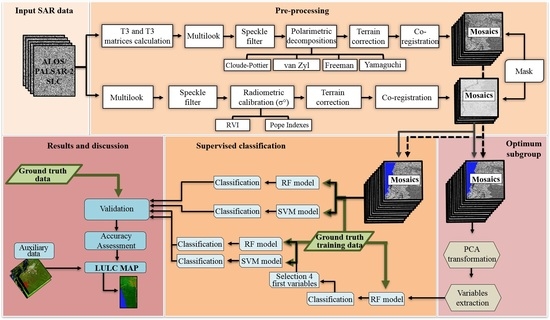Discriminating Forest Successional Stages, Forest Degradation, and Land Use in Central Amazon Using ALOS/PALSAR-2 Full-Polarimetric Data
Abstract
1. Introduction
2. Materials and Methods
2.1. Study Area
2.2. Field Data
2.3. ALOS/PALSAR-2 Data and Preprocessing
2.4. Water Body Masking
2.5. LULC Classes
2.6. Optimum Subgroup Definition
Principal Component Analysis
2.7. Classification and Evaluation
3. Results
3.1. Optimum Subgroup Classification
3.2. LULC Classification
4. Discussion
5. Conclusions
Author Contributions
Funding
Acknowledgments
Conflicts of Interest
Appendix A. Methods
Appendix A.1. Polarimetric Decompositions
Appendix A.2. Biophysical Indices
References
- IBGE. Amazônia Legal. Available online: https://www.ibge.gov.br/geociencias/cartas-e-mapas/mapas-regionais/15819-amazonia-legal.html?=&t=o-que-e (accessed on 9 July 2020).
- Diniz, C.G.; Souza, A.A.; Santos, D.C.; Dias, M.C.; Luz, N.C.; Moraes, D.R.V.; Maia, J.S.A.; Gomes, A.R.; Narvaes, I.S.; Valeriano, D.M.; et al. DETER-B: The new Amazon near real-time deforestation detection system. IEEE J. Sel. Top. Appl. Earth Obs. Remote Sens. 2015, 8, 3619–3628. [Google Scholar] [CrossRef]
- Gloor, E. The fate of Amazonia. Nat. Clim. Chang. 2019, 9, 355–356. [Google Scholar] [CrossRef]
- Andresen, E.; Arroyo-Rodríguez, V.; Escobar, F. Tropical Biodiversity: The Importance of Biotic Interactions for Its Origin, Maintenance, Function, and Conservation. In Ecological Networks in the Tropics; Dáttilo, W., Rico-Gray, V., Eds.; Springer: Cham, Switzerland, 2018; pp. 1–13. [Google Scholar]
- Alamgir, M.; Campbell, M.J.; Turton, S.M.; Pert, P.L.; Edwards, W.; Laurance, W.F. Degraded tropical rainforests possess valuable carbon storage opportunities in a complex, forested landscape. Sci. Rep. 2016, 6, 1–10. [Google Scholar] [CrossRef]
- West, T.A.P.; Borner, J.; Fearnside, P.M. Climatic benefits from the 2006–2017 avoided deforestation in Amazonian Brazil. Front. For. Glob. Chang. 2019, 2, 1–11. [Google Scholar] [CrossRef]
- INPE. Taxas de Desmatamento. Available online: http://terrabrasilis.dpi.inpe.br/app/dashboard/deforestation/biomes/legal_amazon/rates (accessed on 5 May 2019).
- INPE. Estimates for the Amazon: Deforestation-Driven Gross Emissions (Old Growth Forests). Available online: http://inpe-em.ccst.inpe.br/en/estimates-for-the-amazon/ (accessed on 7 October 2020).
- Gibbs, H.K.; Ruesch, A.S.; Achard, F.; Clayton, M.K.; Holmgren, P.; Ramankutty, N.; Foley, J.A. Tropical forests were the primary sources of new agricultural land in the 1980s and 1990s. Proc. Natl. Acad. Sci. USA 2010, 107, 16732–16737. [Google Scholar] [CrossRef]
- Gomez, M.D.V.; Beuchle, R.; Shimabukuro, Y.; Grecchi, R.; Simonetti, D.; Eva, H.D.; Achard, F. A long-term perspective on deforestation rates in the Brazilian Amazon. Int. Arch. Photogramm. Remote Sens. Spat. Inf. Sci. ISPRS Arch. 2015, 40, 539–544. [Google Scholar] [CrossRef]
- Barlow, J.; Berenguer, E.; Carmenta, R.; França, F. Clarifying Amazonia’s burning crisis. Glob. Chang. Biol. 2019, 2019, 1–3. [Google Scholar] [CrossRef]
- Escobar, H. Amazon fires clearly linked to deforestation, scientists say. Science 2019, 365, 853. [Google Scholar] [CrossRef]
- INPE. Monitoramento Dos Focos Ativos Por Bioma. Available online: http://queimadas.dgi.inpe.br/queimadas/portal-static/estatisticas_estados/ (accessed on 24 July 2020).
- Bebber, D.P. The Brazilian Amazon protected area network was largely unaffected by recent satellite-detectable fires. bioRxiv 2019, 1–7. [Google Scholar] [CrossRef]
- Davidson, E.A.; Araújo, A.C.; Artaxo, P.; Balch, J.K.; Brown, I.F.; Bustamante, M.C.; Coe, M.; Defries, R.S.; Keller, M.; Longo, M.; et al. The Amazon basin in transition. Nature 2012, 481, 321–328. [Google Scholar] [CrossRef]
- Lewis, S.L.; Edwards, D.P.; Galbraith, D. Increasing human dominance of tropical forests. Science 2015, 349, 827–832. [Google Scholar] [CrossRef] [PubMed]
- Laurance, W.F.; Vasconcelos, H.L.; Lovejoy, T.E. Forest loss and fragmentation in the Amazon: Implications for wildlife conservation. Oryx 2000, 34, 39–45. [Google Scholar] [CrossRef]
- Barlow, J.; Lennox, G.D.; Ferreira, J.; Berenguer, E.; Lees, A.C.; Nally, R.M.; Thomson, J.R.; Ferraz, S.F.D.B.; Louzada, J.; Oliveira, V.H.F.; et al. Anthropogenic disturbance in tropical forests can double biodiversity loss from deforestation. Nature 2016, 535, 144–147. [Google Scholar] [CrossRef] [PubMed]
- Diele-Viegas, L.M.; Rocha, C.F.D. Why releasing mining on Amazonian indigenous lands and the advance of agrobusiness is extremely harmful for the mitigation of world’s climate change? Comment on Pereira et al. (Environmental Science & Policy 100 (2019) 8–12). Environ. Sci. Policy 2020, 103, 30–31. [Google Scholar]
- Ricketts, T.H.; Soares-Filho, B.; Fonseca, G.A.B.; Nepstad, D.; Pfaf, A.; Petsonk, A.; Anderson, A.; Boucher, D.; Cattaneo, A.; Conte, M.; et al. Indigenous lands, protected areas, and slowing climate change. PLoS Biol. 2010, 8, e1000331. [Google Scholar] [CrossRef]
- Souza, A.; Monteiro, A.M.V.; Rennó, C.D.; Almeida, C.A.; Valeriano, D.M.; Morelli, F.; Vinhas, L.; Maurano, L.E.P.; Adami, M.; Escada, M.I.S.; et al. Metodologia Utilizada nos Projetos PRODES e DETER; INPE: São José dos Campos, Brazil, 2019. [Google Scholar]
- INPE. Monitoramento dos focos Ativos por Estado. Available online: http://queimadas.dgi.inpe.br/queimadas/portal-static/estatisticas_estados/ (accessed on 24 July 2020).
- TCU. Relatório de Auditoria Operacional, Unidade de Conservação Floresta Nacional do Tapajós. Available online: http://www.tcu.gov.br/Consultas/Juris/Docs/judoc%5CAcord%5C20080516%5C004-088-2004-0-AN-Agrupados.doc (accessed on 17 November 2019).
- Andrade, D.F.C.D.; Gama, J.R.V.; Ruschel, A.R.; Melo, L.O.; Avila, A.L.D.; Carvalho, J.O.P.D. Post-fire recovery of a dense ombrophylous forest in Amazon. An. Acad. Bras. Cienc. 2019, 91, 1–11. [Google Scholar] [CrossRef]
- Brazil. Law n 12.678, from 25 June 2012. Available online: http://www.planalto.gov.br/ccivil_03/_Ato2011-2014/2012/Lei/L12678.htm (accessed on 18 June 2019).
- Metzger, J.P.; Bustamante, M.M.C.; Ferreira, J.; Fernandes, G.W.; Librán-Embid, F.; Pillar, V.D.; Prist, P.R.; Rodrigues, R.R.; Vieira, I.C.G.; Overbeck, G.E. Why Brazil needs its legal reserves. Perspect. Ecol. Conserv. 2019, 17, 91–103. [Google Scholar] [CrossRef]
- Fichera, C.R.; Modica, G.; Pollino, M. Land cover classification and change-detection analysis using multi-temporal remote sensed imagery and landscape metrics. Eur. J. Remote Sens. 2012, 45, 1–18. [Google Scholar] [CrossRef]
- Guerra, J.B.; Mura, J.C.; Freitas, C.C. Discriminação de incrementos de desflorestamento na Amazônia com dados SAR R99B em banda L. Acta Amaz. 2010, 40, 557–566. [Google Scholar] [CrossRef]
- Negri, R.G.; Dutra, L.V.; Freitas, C.C.; Dengsheng, L. Exploring the capability of ALOS PALSAR L-band fully polarimetric data for land cover classification in tropical environments. IEEE J. Sel. Top. Appl. Earth Obs. Remote Sens. 2016, 9, 5369–5384. [Google Scholar] [CrossRef]
- Cazcarra-Bes, V.; Tello-Alonso, M.; Fischer, R.; Heym, M.; Papathanassiou, K. Monitoring of forest structure dynamics by means of L-band SAR tomography. Remote Sens. 2017, 9, 1229. [Google Scholar] [CrossRef]
- Li, G.; Lu, D.; Moran, E.; Dutra, L.; Batistella, M. A comparative analysis of ALOS PALSAR L-band and RADARSAT-2 C-band data for land-cover classification in a tropical moist region. ISPRS J. Photogramm. Remote Sens. 2012, 70, 26–38. [Google Scholar] [CrossRef]
- Varghese, A.O.; Suryavanshi, A.; Joshi, A.K. Analysis of different polarimetric target decomposition methods in forest density classification using C-band SAR data. Int. J. Remote Sens. 2016, 37, 694–709. [Google Scholar] [CrossRef]
- Chen, W.; Jiang, H.; Moriya, K.; Sakai, T.; Cao, C. Monitoring of post-fire forest regeneration under different restoration treatments based on ALOS/PALSAR data. New For. 2018, 49, 105–121. [Google Scholar] [CrossRef]
- Urbazaev, M.; Cremer, F.; Migliavacca, M.; Reichstein, M.; Schmullius, C.; Thiel, C. Potential of multi-temporal ALOS-2 PALSAR-2 ScanSAR data for vegetation height estimation in tropical forests of Mexico. Remote Sens. 2018, 10, 1277. [Google Scholar] [CrossRef]
- Pôssa, E.M.; Gama, F.F.; Santos, J.R.; Mura, J.C.; Bispo, P.C. Análise de uso da terra e cobertura florestal na Amazônia central, a partir de dado polarimétrico PALSAR/ALOS-1 e coerência interferométrica TanDEM-X. Rev. Bras. Geogr. Física 2018, 11, 2094–2108. [Google Scholar] [CrossRef]
- Pereira, L.O.; Freitas, C.C.; Sant’Anna, S.J.S.; Reis, M.S. ALOS/PALSAR data evaluation for land use and land cover mapping in the Amazon region. IEEE J. Sel. Top. Appl. Earth Obs. Remote Sens. 2016, 9, 5413–5423. [Google Scholar] [CrossRef]
- Mermoz, S.; Le Toan, T. Forest disturbances and regrowth assessment using ALOS PALSAR data from 2007 to 2010 in Vietnam, Cambodia and Lao PDR. Remote Sens. 2016, 8, 217. [Google Scholar] [CrossRef]
- Martins, F.S.R.V.; Santos, J.R.; Galvão, L.S.; Xaud, H.A.M. Sensitivity of ALOS/PALSAR imagery to forest degradation by fire in northern Amazon. Int. J. Appl. Earth Obs. Geoinf. 2016, 49, 163–174. [Google Scholar] [CrossRef]
- Pavanelli, J.A.P.; Santos, J.R.; Galvão, L.S.; Xaud, M.R.; Xaud, H.A.M. Palsar-2/ALOS-2 and Oli/Landsat-8 data integration for land use and land cover mapping in northern Brazilian Amazon. Bol. Ciênc. Geod. 2018, 24, 250–269. [Google Scholar] [CrossRef]
- De Alban, J.D.T.; Connette, G.M.; Oswald, P.; Webb, E.L. Combined Landsat and L-band SAR data improves land cover classification and change detection in dynamic tropical landscapes. Remote Sens. 2018, 10, 306. [Google Scholar] [CrossRef]
- Hagensieker, R.; Waske, B. Evaluation of multi-frequency SAR images for tropical land cover mapping. Remote Sens. 2018, 10, 257. [Google Scholar] [CrossRef]
- Copping, P.R.; Bauer, M.E. Digital change detection in forest ecossystems with remote sensing imagery. Remote Sens. 1996, 13, 207–234. [Google Scholar]
- Lu, D.; Mausel, P.; Brondízio, E.; Moran, E. Change detection techniques. Int. J. Remote Sens. 2004, 25, 2365–2407. [Google Scholar] [CrossRef]
- Cakir, H.I.; Khorram, S.; Nelson, S.A.C. Correspondence analysis for detecting land cover change. Remote Sens. Environ. 2006, 102, 306–317. [Google Scholar] [CrossRef]
- Desclée, B.; Bogaert, P.; Defourny, P. Forest change detection by statistical object-based method. Remote Sens. Environ. 2006, 102, 1–11. [Google Scholar] [CrossRef]
- Grant, R.F.; Hutyra, L.R.; Oliveira, R.C.; Munger, J.W.; Saleska, S.R.; Wofsy, C. Modeling the carbon balance of Amazonian rainforests: Resolving ecological controls on net ecosystem productivity. Ecol. Monogr. 2009, 79, 445–463. [Google Scholar] [CrossRef]
- Bispo, P.C.; Santos, J.R.; Valeriano, M.M.; Touzi, R.; Seifert, F.M. Integration of polarimetric PALSAR attributes and local geomorphometric variables derived from SRTM for forest biomass modeling in central Amazonia. Can. J. Remote Sens. 2014, 40, 26–42. [Google Scholar] [CrossRef]
- Bispo, P.C.; Pardini, M.; Papathanassiou, K.P.; Kugler, F.; Balzter, H.; Rains, D.; Santos, J.R.; Rizaev, I.G.; Tansey, K.; Santos, M.N.; et al. Mapping forest successional stages in the Brazilian Amazon using forest heights derived from TanDEM-X SAR interferometry. Remote Sens. Environ. 2019, 232, 111194. [Google Scholar] [CrossRef]
- Ricklefs, R.; Relyea, R. Ecology: The Economy of Nature, 7th ed.; W.H. Freeman: New York, NY, USA, 2013. [Google Scholar]
- Yang, Y.; Saatchi, S.S.; Xu, L.; Yu, Y.; Choi, S.; Phillips, N.; Kennedy, R.; Keller, M.; Knyazikhin, Y.; Myneni, R.B. Post-drought decline of the Amazon carbon sink. Nat. Commun. 2018, 9, 1–9. [Google Scholar] [CrossRef] [PubMed]
- Wiederkehr, N.C.; Gama, F.F.; Mura, J.C.; Santos, J.R.; Bispo, P.C.; Sano, E.E. Analysis of the target decomposition technique attributes and polarimetric ratios to discriminate land use and land cover classes of the Tapajós region. Bol. Ciênc. Geod. 2019, 25, 1–16. [Google Scholar] [CrossRef]
- Silva, R.D.; Galvão, L.S.; Santos, J.R.; Silva, C.V.J.; Moura, Y.M. Spectral/textural attributes from ALI/EO-1 for mapping primary and secondary tropical forests and studying the relationships with biophysical parameters. GISci. Remote Sens. 2014, 51, 677–694. [Google Scholar] [CrossRef]
- Silva, C.V.J.; Santos, J.R.; Galvão, L.S.; Silva, R.D.; Moura, Y.M. Floristic and structure of an Amazonian primary forest and a chronosequence of secondary succession. Acta Amaz. 2016, 46, 133–150. [Google Scholar] [CrossRef]
- Vieira, I.C.G.; Almeida, A.S.; Davidson, E.A.; Stone, T.A.; Carvalho, C.J.R.; Guerrero, J.B. Classifying successional forests using Landsat spectral properties and ecological characteristics in eastern Amazônia. Remote Sens. Environ. 2003, 87, 470–481. [Google Scholar] [CrossRef]
- Uhl, C.; Buschbacher, R.; Serrao, E.A.S. Abandoned pastures in eastern Amazonia. I. Patterns of plant succession. J. Ecol. 1988, 76, 663–681. [Google Scholar] [CrossRef]
- Lee, J.; Grunes, M.R.; Grandi, G. Polarimetric SAR speckle filtering and its implication for classification. IEEE Trans. Geosci. Remote Sens. 1999, 37, 2363–2373. [Google Scholar]
- Cloude, S.R.; Pottier, E. A review of target decomposition theorems in radar polarimetry. IEEE Trans. Geosci. Remote Sens. 1996, 34, 498–518. [Google Scholar] [CrossRef]
- Van Zyl, J.J. Application of Cloude’s target decomposition theorem to polarimetric imaging radar data. Radar Polarim. SPIE 1992, 184–191. [Google Scholar]
- Freeman, A.; Durden, S.L. A three-component scattering model for polarimetric SAR data. IEEE Trans. Geosci. Remote Sens. 1998, 36, 963–973. [Google Scholar] [CrossRef]
- Yamaguchi, Y.; Moriyama, T.; Ishido, M.; Yamada, H. Four-component scattering model for polarimetric SAR image decomposition. IEEE Trans. Geosci. Remote Sens. 2005, 43, 1699–1706. [Google Scholar] [CrossRef]
- Sun, S.; Liu, R.; Wen, W. Unsupervised classification method for polarimetric synthetic aperture radar imagery based on Yamaguchi four-component decomposition model. J. Electr. Comput. Eng. 2015, 2015, 1–7. [Google Scholar] [CrossRef]
- Kim, Y.; van Zyl, J.J. A time-series approach to estimate soil moisture using polarimetric radar data. IEEE Trans. Geosci. Remote Sens. 2009, 47, 2519–2527. [Google Scholar]
- Pope, K.O.; Rey-Benayas, J.M.; Paris, J.F. Radar remote sensing of forest and wetland ecosystems in the Central American tropics. Remote Sens. Environ. 1994, 48, 205–219. [Google Scholar] [CrossRef]
- Goumehei, E.; Tolpekin, V.; Stein, A.; Yan, W. Surface water body detection in polarimetric SAR data using contextual complex Wishart classification. Water Resour. Res. 2019, 55, 7047–7059. [Google Scholar] [CrossRef]
- ANA. Rios Principais. Available online: https://metadados.ana.gov.br/geonetwork/srv/pt/main.home (accessed on 17 November 2019).
- Exelis Visual Information Solutions-ENVI, v. 5.0; EXELIS: Boulder, Colorado, 2014.
- Mendes, F.S.; Baron, D.; Gerold, G.; Liesenberg, V.; Erasmi, S. Optical and SAR remote sensing synergism for mapping vegetation types in the endangered Cerrado/Amazon ecotone of Nova Mutum-Mato Grosso. Remote Sens. 2019, 11, 1161. [Google Scholar] [CrossRef]
- Jolliffe, I.T. Principal Component Analysis; Springer: New York, NY, USA, 2002. [Google Scholar]
- Li, Q.; Gong, L.; Zhang, J. A correlation change detection method integrating PCA and multi-texture features of SAR image for building damage detection. Eur. J. Remote Sens. 2019, 52, 435–447. [Google Scholar] [CrossRef]
- Mackiewicz, A.; Ratajczak, W. Principal Components Analysis (PCA). Comput. Geosci. 1993, 19, 303–342. [Google Scholar] [CrossRef]
- R Core Team. R: A language and environment for statistical computing. Viena, R Foundation for Statistical Computing. 2020. Available online: https://www.R-project.org/ (accessed on 10 September 2019).
- Camargo, F.F.; Sano, E.E.; Almeida, C.M.; Mura, J.C.; Almeida, T. A comparative assessment of machine-learning techniques for land use and land cover classification of the Brazilian tropical savanna using ALOS-2/PALSAR-2 polarimetric images. Remote Sens. 2019, 45, 1600. [Google Scholar] [CrossRef]
- Furtado, L.F.A.; Silva, T.S.F.; Novo, E.M.L.M. Dual-season and full-polarimetric C band SAR assessment for vegetation mapping in the Amazon varzea wetlands. Remote Sens. Environ. 2016, 174, 212–222. [Google Scholar] [CrossRef]
- Du, P.; Samat, A.; Waske, B.; Liu, S.; Li, Z. Random Forest and Rotation Forest for fully polarized SAR image classification using polarimetric and spatial features. ISPRS J. Photogramm. Remote Sens. 2015, 105, 38–53. [Google Scholar] [CrossRef]
- Diniz, J.M.F.S.; Gama, F.F.; Adami, M. Evaluation of polarimetry and interferometry of Sentinel-1A SAR data for land use and land cover of the Brazilian Amazon region. Geocarto Int. 2020, 6049, 1–17. [Google Scholar] [CrossRef]
- Shiraishi, T.; Motohka, T.; Thapa, R.B.; Watanabe, M.; Shimada, M. Comparative assessment of supervised classifiers for land use-land cover classification in a tropical region using time-series PALSAR mosaic data. IEEE J. Sel. Top. Appl. Earth Obs. Remote Sens. 2014, 7, 1186–1199. [Google Scholar] [CrossRef]
- Numbisi, F.N.; van Coillie, F.; Wulf, R. Multi-date Sentinel-1 SAR image textures discriminate perennial agroforests in a tropical forest-savannah transition landscape. Int. Arch. Photogramm. Remote Sens. Spat. Inf. Sci. 2018, 42, 339–346. [Google Scholar] [CrossRef]
- Breiman, L. Random Forests. Mach. Learn. 2001, 45, 5–32. [Google Scholar] [CrossRef]
- Eisavi, V.; Homayouni, S.; Yazdi, A.M.; Alimohammadi, A. Land cover mapping based on random forest classification of multitemporal spectral and thermal images. Environ. Monit. Assess. 2015, 187, 1–14. [Google Scholar] [CrossRef] [PubMed]
- Wang, Y.; Chen, W.; Huang, K.; Gu, Q. Classification of neonatal amplitude-integrated EEG using random forest model with combined feature. In Proceedings of the IEEE International Conference on Bioinformatics and Biomedicine (BIBM), Shanghai, China, 18–21 December 2013; pp. 285–290. [Google Scholar]
- Cutler, D.R.; Edwards, T.C.; Beard, K.H.; Cutler, A.; Kyle, T.; Gibson, J.; Lawler, J.J.; Beard, H.; Hess, T. Random Forests for classification in ecology. Ecology 2007, 88, 2783–2792. [Google Scholar] [CrossRef] [PubMed]
- Boardman, M.; Trappenberg, T. A heuristic for free parameter optimization with Support Vector Machines. In Proceedings of the IEEE International Joint Coference on Neural Network, Vancouver, BC, Canada, 16–21 July 2006; pp. 610–617. [Google Scholar]
- Vapnik, V.N. Statistical Learning Theory; Haykin, S., Ed.; Wiley: New York, NY, USA, 1998; Volume 3. [Google Scholar]
- Cortes, C.; Vapnik, V. Support-Vector Networks. Machine Learn. 1995, 20, 273–297. [Google Scholar] [CrossRef]
- Abe, S. Support Vector Machines for Pattern Classification, 2nd ed.; Springer: London, UK, 2010. [Google Scholar]
- Vapnik, V.N. The Nature of Statistical Learning Theory; Springer: New York, NY, USA, 1995. [Google Scholar]
- Meyer, D. Support Vector Machines. The Interface to libsvm in package. Porting R Darwin/X11 Mac OS X 2001, 1, 23. [Google Scholar]
- Henderson, F.M.; Lewis, A.J. Manual of Remote Sensing: Principles and Applications of Imaging Radar, 3rd ed.; John Wiley Sons: New York, NY, USA, 1998; 866p. [Google Scholar]
- Avtar, R.; Takeuchi, W.; Sawada, H. Full polarimetric PALSAR-based land cover monitoring in Cambodia for implementation of REDD policies. Int. J. Digit. Earth 2013, 6, 255–275. [Google Scholar] [CrossRef]
- Ullmann, T.; Banks, S.N.; Schmitt, A.; Jagdhuber, T. Scattering characteristics of X-, C- and L-band PolSAR data examined for the tundra environment of the Tuktoyaktuk Peninsula, Canada. Appl. Sci. 2017, 7, 595. [Google Scholar] [CrossRef]
- Trisasongko, B.H. The use of polarimetric SAR data for forest disturbance monitoring. Sens. Imaging 2010, 11, 1–13. [Google Scholar] [CrossRef]
- Narvaes, I.S.; Santos, J.R.; Silva, A.Q. Analysis of structural parameters of forest typologies using L-band SAR data. Bol. Ciênc. Geod. 2010, 16, 475–489. [Google Scholar] [CrossRef]
- Kuplich, T.M.; Shimabukuro, Y.E.; Servello, E.; Sano, E. Polarimetric signatures and classification of tropical land covers. In Proceedings of the International Geoscience and Remote Sensing Symposium (IGARSS 2009), Cape Town, South Africa, 12–17 July 2009; University of Cape Town: Cape Town, South Africa, 2009; pp. 118–121. [Google Scholar]
- Tanase, M.A.; Santoro, M.; Aponte, C.; Riva, J. Polarimetric properties of burned forest areas at C- and L-band. IEEE J. Sel. Top. Appl. Earth Obs. Remote Sens. 2014, 7, 267–276. [Google Scholar] [CrossRef]
- Plank, S.; Karg, S.; Martinis, S. Full-polarimetric burn scar mapping—The differences of active fire and post-fire situations. Int. J. Remote Sens. 2018, 1–16. [Google Scholar] [CrossRef]
- Qi, Z.; Yeh, A.G.O.; Li, X.; Lin, Z. A novel algorithm for land use and land cover classification using RADARSAT-2 polarimetric SAR data. Remote Sens. Environ. 2012, 118, 21–39. [Google Scholar] [CrossRef]
- Middinti, S.; Jha, C.S.; Reddy, T.B. Forest type classification with combination of advanced polarimetric decompositions and textures of L-band synthetic aperture radar data. J. Appl. Remote Sens. 2017, 11, 016035. [Google Scholar] [CrossRef]
- Mirelva, P.R.; Nagasawa, R. Application of ALOS PALSAR data for agriculture croplands classification in central Java, Indonesia. J. Jpn. Agric. Syst. Soc. 2017, 33, 27–36. [Google Scholar]
- Van Zyl, J.J.; Arii, M.; Kim, Y. Model-based decomposition of polarimetric SAR covariance matrices constrained for nonnegative eigenvalues. IEEE Trans. Geosci. Remote Sens. 2011, 49, 3452–3459. [Google Scholar] [CrossRef]




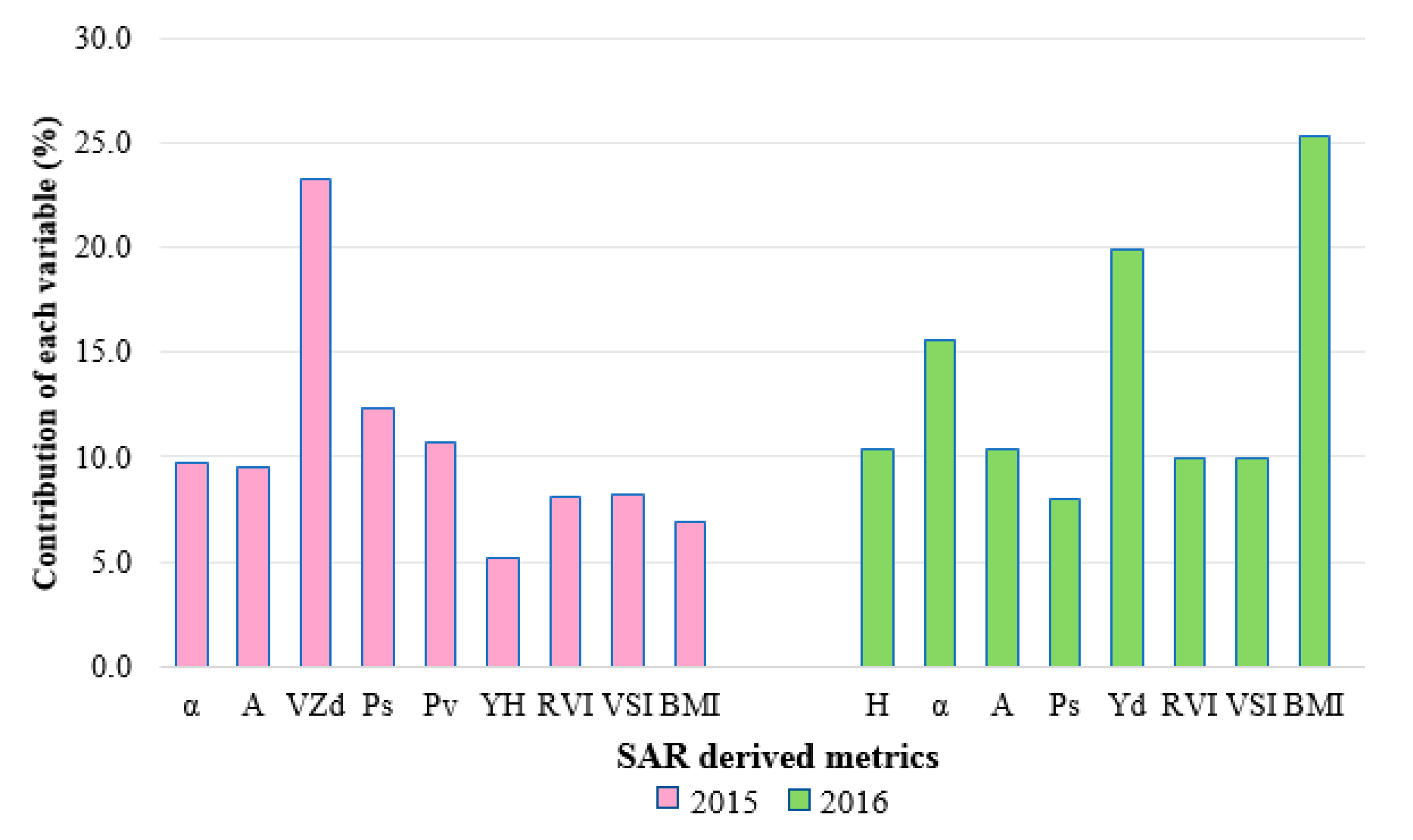


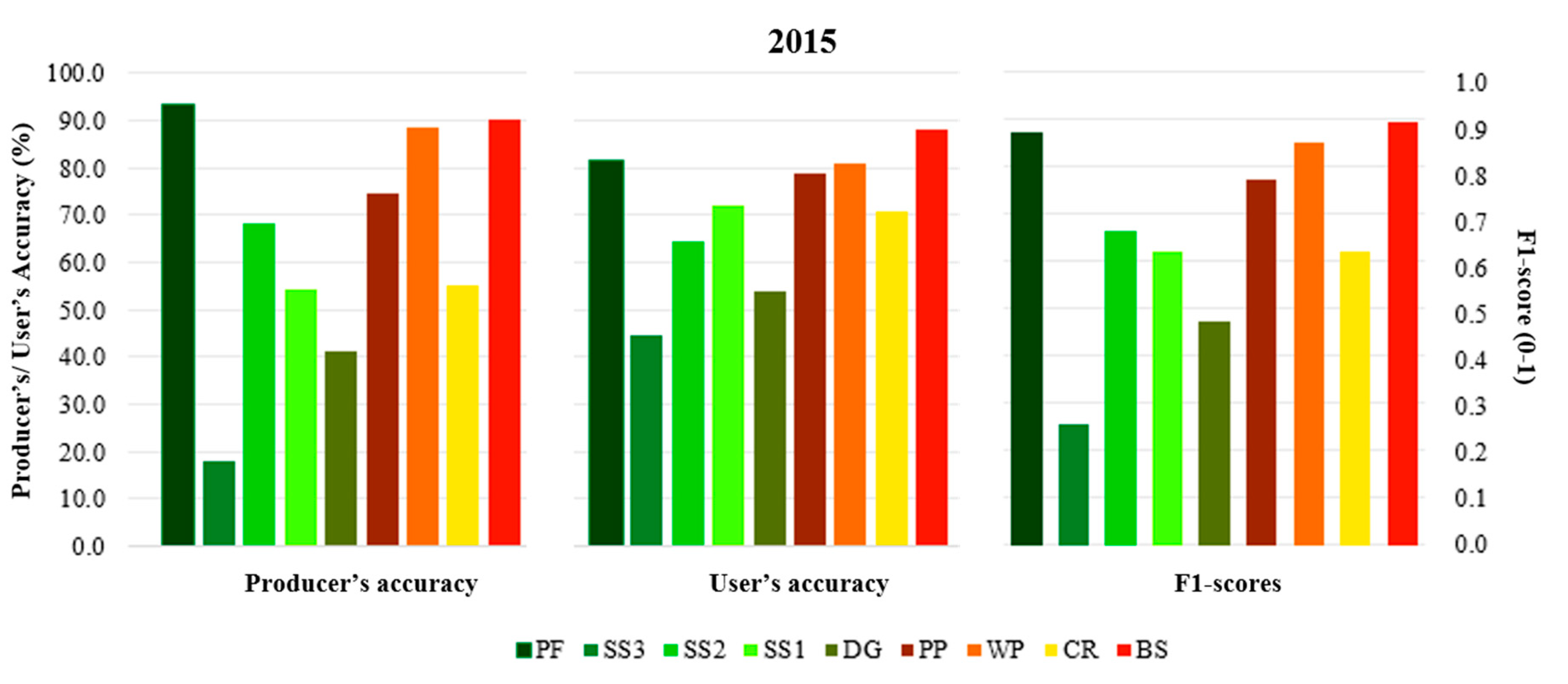

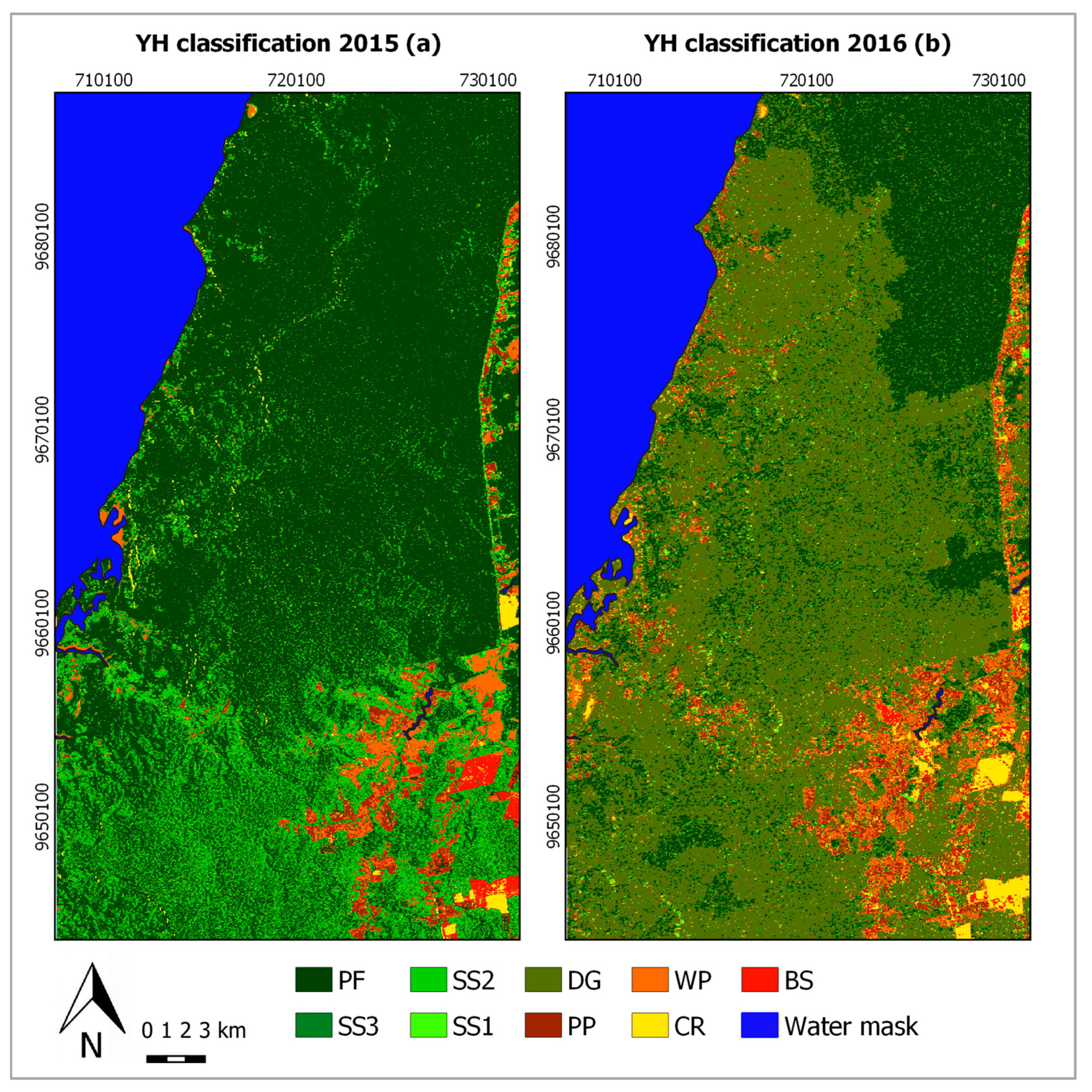
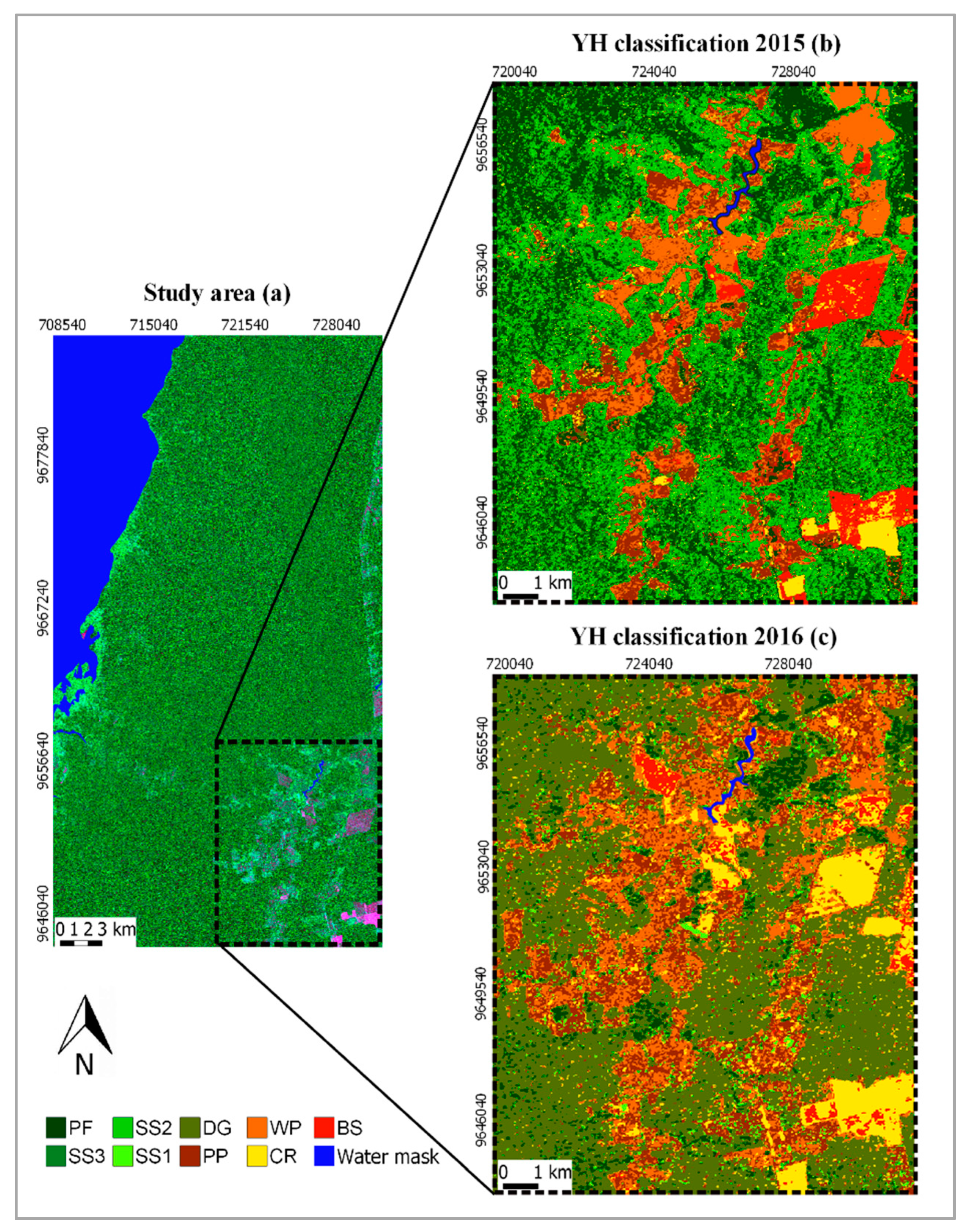
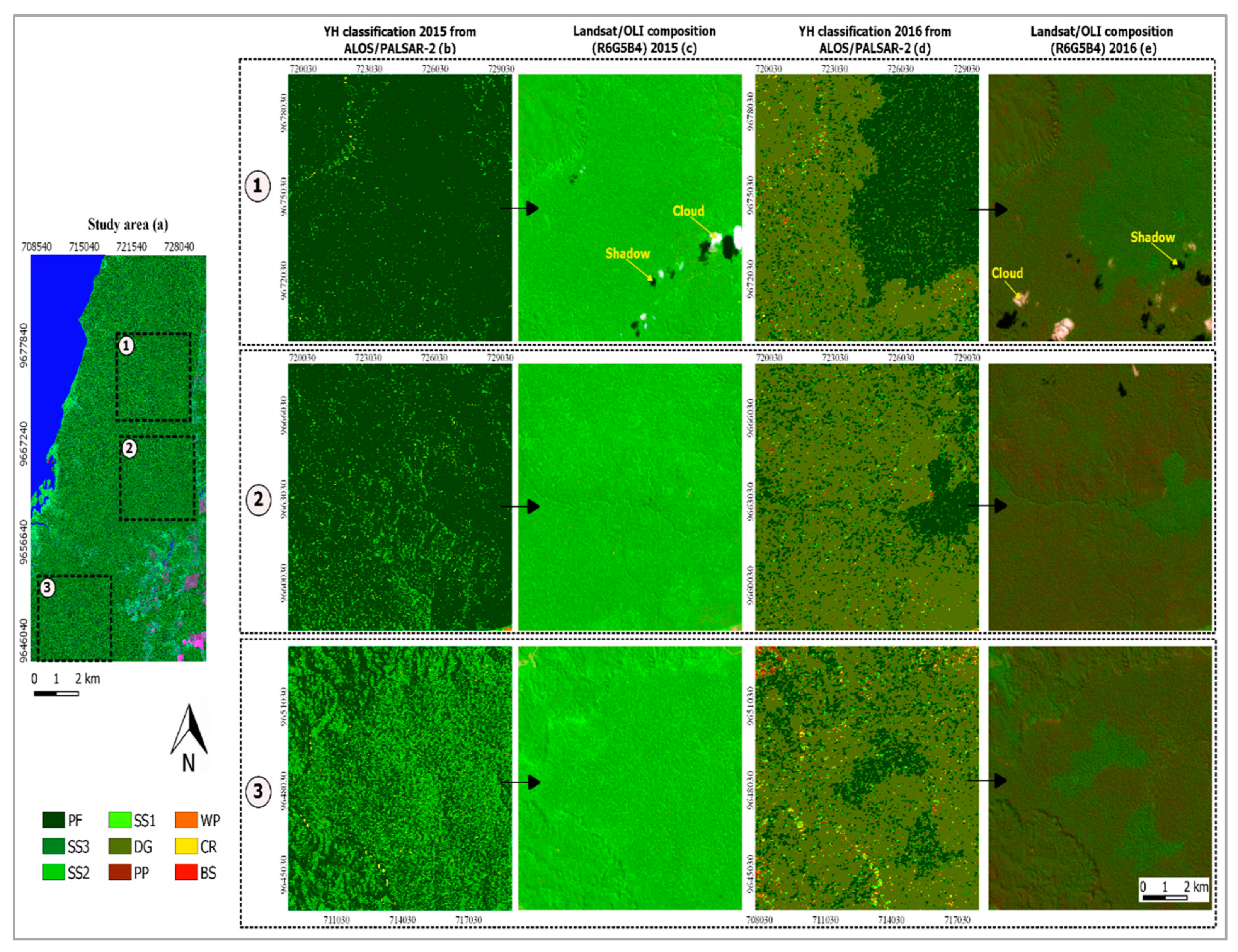
| Initials | LULC Class | Description |
|---|---|---|
| PF | Primary Forest | Forests without anthropogenic alterations or with weak or well managed selective logging activities |
| SS3 | Advanced Secondary Succession | >15 years of regeneration |
| SS2 | Intermediate Secondary Succession | 5–15 years of regeneration |
| SS1 | Initial Secondary Succession | <5 years of regeneration |
| DG | Degraded Forest | Forests severely affected by fires and/or unsustainable logging |
| PP | Poorly Managed Pasture | Pastures with high incidence of shrubs, palms, and trees |
| WP | Well Managed Pasture | Pastures with low incidence of shrubs and trees |
| CR | Cropland | Annual crops, mostly soybean, rice, and maize in different phenological stages |
| BS | Bare Soil/Fallow | Soils prepared for crop planting or temporarily without crop plantation (fallow) |
| Overpass | Range Resolution (m) | Azimuth Resolution (m) | Incidence Angle (degree) | 3-Day Accumulated Precipitation (mm) before SAR Overpass |
|---|---|---|---|---|
| 12/28/2014 | 3.13 | 2.86 | 33.86 | 0.00 |
| 04/19/2015 | 3.21 | 2.86 | 33.87 | 19.87 |
| 05/03/2015 | 3.13 | 2.86 | 31.10 | 10.33 |
| 04/17/2016 | 3.21 | 2.86 | 33.87 | 1.07 |
| 05/01/2016 | 3.13 | 2.86 | 31.08 | 27.17 |
| 05/01/2016 | 3.13 | 2.86 | 31.09 | 27.17 |
| Attributes | Symbol | Description | Source | Equation |
|---|---|---|---|---|
| Entropy | H | Number of dominant scattering mechanisms | Cloude and Pottier [57] | |
| Mean alpha angle | Dominant scattering mechanism | |||
| Anisotropy | A | Measures the relative importance of the second and third scattering types | ||
| Surface scattering | VZs | Portion of surface scattering | van Zyl [58] | |
| Double-bounce | VZd | Portion of double-bounce scattering | ||
| Volumetric scattering | VZv | Portion of volumetric scattering | ||
| Surface scattering | Ps | Portion of surface scattering | Freeman and Durden [59] | |
| Double-bounce | Pd | Modeled from two orthogonal surfaces | ||
| Volumetric scattering | Pv | Modeled from a cloud of fine cylindrical scatterers randomly distributed | ||
| Surface scattering | Ys | Portion of surface scattering | Yamaguchi et al. [60] | |
| Double-bounce | Yd | Modeled from two orthogonal surfaces | ||
| Volumetric scattering | Yv | Modeled from a cloud of very fine and cylindrical scatterers randomly distributed | ||
| Helix scattering | YH | Helix shape scattering | ||
| Radar Vegetation Index | RVI | Parameter sensitive to the biomass level | Kim and van Zyl [62] | |
| Canopy Structure Index | CSI | Parameter that measures the relative importance of horizontal versus vertical structure in the vegetation | Pope et al. [63] | |
| Volume Scattering Index | VSI | Parameter indicating canopy density or thickness | ||
| Biomass Index | BMI | Indicator parameter of the relative amount of woody compared to leafy biomass |
| Classes | 2015 | 2016 | ||||
|---|---|---|---|---|---|---|
| Polygon | Pixel | Area (ha) | Polygon | Pixel | Area (ha) | |
| PF | 116 | 1044 | 20.88 | 47 | 423 | 8.46 |
| SS3 | 22 | 198 | 3.96 | 5 | 45 | 0.90 |
| SS2 | 37 | 333 | 6.66 | 11 | 99 | 1.98 |
| SS1 | 09 | 81 | 1.62 | 18 | 162 | 3.24 |
| DG | 09 | 81 | 1.62 | 77 | 693 | 13.86 |
| PP | 26 | 234 | 4.68 | 40 | 360 | 7.20 |
| WP | 30 | 270 | 5.40 | 28 | 252 | 5.04 |
| CR | 21 | 189 | 3.78 | 31 | 279 | 5.58 |
| BS | 18 | 162 | 3.24 | 10 | 90 | 1.80 |
| Total | 288 | 2592 | 51.84 | 267 | 2403 | 48.06 |
| 2015 | |||||
| Optimum Subgroup Attributes | Classifier | OA (%) | CI. 95% | Kappa | Processing Time (s) |
| α, A, Pv, VZd | RF | 75.4 | 71.9–78.7 | 0.68 | 686.40 |
| SVM | 70.9 | 67.2–74.4 | 0.62 | 1080.00 | |
| 2016 | |||||
| H, A, Ps, BMI | RF | 79.9 | 76.4–83.0 | 0.76 | 889.16 |
| SVM | 76.8 | 73.2–80.2 | 0.71 | 867.60 | |
| 2015 | |||||
| Attribute Groups | Classifier | OA (%) | CI. 95% | Kappa | Processing Time (s) |
| CP (H, α, A) | RF | 60.0 | 56.0–64.0 | 0.46 | 564.50 |
| SVM | 64.6 | 60.7–68.3 | 0.50 | 783.89 | |
| VZ (VZs, VZd, VZv) | RF | 70.7 | 67.0–74.2 | 0.61 | 509.80 |
| SVM | 69.8 | 66.0–73.3 | 0.59 | 629.80 | |
| FD (Ps, Pd, Pv) | RF | 72.8 | 69.1–76.2 | 0.64 | 503.84 |
| SVM | 71.3 | 67.7–74.8 | 0.63 | 690.91 | |
| YH (Ys, Yd, Yv, YH) | RF | 76.9 | 73.4–80.1 | 0.70 | 811.48 |
| SVM | 69.8 | 66.0–73.3 | 0.60 | 1246.85 | |
| RVI | RF | 40.4 | 36.5–44.3 | 0.23 | 316.88 |
| SVM | 46.2 | 42.3–50.2 | 0.23 | 755.76 | |
| PI (CSI, VSI, BMI) | RF | 64.0 | 60.2–67.8 | 0.52 | 564.93 |
| SVM | 62.5 | 58.6–66.2 | 0.49 | 887.64 | |
| 2016 | |||||
| Attribute Groups | Classifier | OA (%) | CI. 95% | Kappa | Processing Time (s) |
| CP (H, α, A) | RF | 72.9 | 69.1–76.4 | 0.67 | 696.92 |
| SVM | 72.9 | 69.1–76.4 | 0.67 | 885.80 | |
| VZ (VZs, VZd, VZv) | RF | 79.2 | 75.7–82.4 | 0.74 | 527.91 |
| SVM | 78.2 | 74.6–81.4 | 0.74 | 741.98 | |
| FD (Ps, Pd, Pv) | RF | 80.2 | 76.7–83.4 | 0.76 | 589.55 |
| SVM | 77.0 | 73.3–80.3 | 0.72 | 623.44 | |
| YH (Ys, Yd, Yv, YH) | RF | 83.3 | 80.0–86.2 | 0.80 | 658.07 |
| SVM | 78.7 | 75.1–81.9 | 0.74 | 957.32 | |
| RVI | RF | 32.2 | 28.5–36.2 | 0.18 | 343.07 |
| SVM | 39.8 | 35.8–43.8 | 0.22 | 864.16 | |
| PI (CSI, VSI, BMI) | RF | 56.3 | 52.2–60.4 | 0.46 | 578.22 |
| SVM | 51.0 | 46.9–55. | 0.39 | 906.22 | |
Publisher’s Note: MDPI stays neutral with regard to jurisdictional claims in published maps and institutional affiliations. |
© 2020 by the authors. Licensee MDPI, Basel, Switzerland. This article is an open access article distributed under the terms and conditions of the Creative Commons Attribution (CC BY) license (http://creativecommons.org/licenses/by/4.0/).
Share and Cite
Wiederkehr, N.C.; Gama, F.F.; Castro, P.B.N.; Bispo, P.d.C.; Balzter, H.; Sano, E.E.; Liesenberg, V.; Santos, J.R.; Mura, J.C. Discriminating Forest Successional Stages, Forest Degradation, and Land Use in Central Amazon Using ALOS/PALSAR-2 Full-Polarimetric Data. Remote Sens. 2020, 12, 3512. https://doi.org/10.3390/rs12213512
Wiederkehr NC, Gama FF, Castro PBN, Bispo PdC, Balzter H, Sano EE, Liesenberg V, Santos JR, Mura JC. Discriminating Forest Successional Stages, Forest Degradation, and Land Use in Central Amazon Using ALOS/PALSAR-2 Full-Polarimetric Data. Remote Sensing. 2020; 12(21):3512. https://doi.org/10.3390/rs12213512
Chicago/Turabian StyleWiederkehr, Natalia C., Fabio F. Gama, Paulo B. N. Castro, Polyanna da Conceição Bispo, Heiko Balzter, Edson E. Sano, Veraldo Liesenberg, João R. Santos, and José C. Mura. 2020. "Discriminating Forest Successional Stages, Forest Degradation, and Land Use in Central Amazon Using ALOS/PALSAR-2 Full-Polarimetric Data" Remote Sensing 12, no. 21: 3512. https://doi.org/10.3390/rs12213512
APA StyleWiederkehr, N. C., Gama, F. F., Castro, P. B. N., Bispo, P. d. C., Balzter, H., Sano, E. E., Liesenberg, V., Santos, J. R., & Mura, J. C. (2020). Discriminating Forest Successional Stages, Forest Degradation, and Land Use in Central Amazon Using ALOS/PALSAR-2 Full-Polarimetric Data. Remote Sensing, 12(21), 3512. https://doi.org/10.3390/rs12213512







